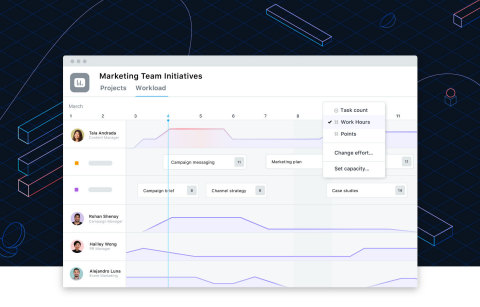SAN FRANCISCO--(BUSINESS WIRE)--Today, Asana, a leading work management platform for teams, announced the introduction of Workload, delivering more ways to plan and balance work across an organization’s most valuable assets — its teams. Workload is now available for teams on Asana’s Business offering.
According to the World Health Organization1, burn-out — a syndrome resulting from chronic workplace stress — has become so prevalent among modern workers that it’s now classified as an occupational phenomenon. In a study of 6,000 knowledge workers across the U.S., U.K. and Australia conducted by Asana and research firm 4media, more than 80 percent of global workers say they consistently feel overworked and close to burn-out, with nearly three-quarters (74 percent) experiencing burnout twice a year or more. While 93 percent of those surveyed believe they are more productive than their peers and teammates, over one-third (37 percent) don’t know whether work is fairly distributed across their teams.
As a result, a majority of respondents believe that their organization’s staff morale is low because of too much work. In addition to lower levels of morale and engagement, nearly half (49 percent) of all businesses surveyed have had employees leave the company due to feeling overwhelmed by their work volume.
“The most productive and happiest teams are those that have clarity of who is doing what by when,” said Alex Hood, Head of Product at Asana. “While today’s workplace has more ways to communicate and collaborate than ever before, the majority of teams are still turning to outdated spreadsheets and email chains to plan and manage their work.”
Hood continues, “We created Workload to give you a centralized view of your team’s capacity that’s connected to the actual underlying work, while factoring in an individual’s unique skills and abilities. With Workload, not only are your most important projects and initiatives completed on time, you never lose sight of your most valuable assets — your team members.”
Introducing Asana Workload
Workload delivers new levels of visibility into work happening across multiple projects in a single view, with the ability to easily reassign or reschedule tasks as business needs change. Because no two organizations, or teams, are the same, Workload allows project participants to customize their workload based on effort — such as hours or points — to better understand exactly how much work everyone has on their plates. To achieve balance and ward off burnout, Workload features capacity limits for individual team members with visual alerts when the work assigned to them exceeds their capacity for a given time period.
“Workload balance in collaboration is missing from today’s work ecosystem, but is required for a good employee experience,” according to Wayne Kurtzman, IDC Research Director for Social, Communities and Collaboration. “Asana’s Workload is an example of where that balance can be restored.”
Teams are most effective when everyone is working on the right priorities at the right time. Pairing Workload with Asana Portfolios gives teams the ability to plan, monitor and manage work across projects. As the mission control for your most important initiatives, Portfolios delivers an accurate, holistic view of how work is tracking towards goals — empowering teams to flexibly and easily take action to keep work on track.
"Panera’s creative team averages 45 projects a week, and before Workload, we didn't have a simplified way to review the team’s bandwidth," said Jenny Williams, Marketing Traffic Manager at Panera Bread. "With Workload, we can easily see assigned tasks and react to bandwidth concerns by negotiating deadlines and, if needed, make a case for additional resources."
Starting today, Workload is available on Asana’s Business offering starting at $19.99 per member, per month. For more information, visit Asana.com.
Methodology
This report is based on a survey of 6,018 knowledge workers in the U.S., U.K., Australia and New Zealand. The research was divided across 2,410 U.S. workers, 2,404 U.K. workers and 1,204 Australia/NZ workers. The survey targeted workers of varying industries, job levels, and ages. It was conducted by 4media on behalf of Asana in June 2019.
About Asana
Asana helps teams organize and manage all of their work, from small projects to strategic initiatives. Headquartered in San Francisco, CA, Asana has more than 70,000 paying organizations and millions of free organizations across 195 countries. Global customers such as AB-InBev, Airbnb, KLM Air France, NASA, Overstock.com, Uber, Viessmann Group and Vox Media rely on Asana to manage everything from company objectives to digital transformation to product launches and marketing campaigns.
[1] https://www.who.int/mental_health/evidence/burn-out/en/




